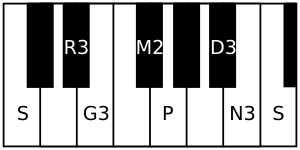| Arohanam | S R₃ G₃ M₂ P D₃ N₃ Ṡ |
|---|---|
| Avarohanam | Ṡ N₃ D₃ P M₂ G₃ R₃ S |
| Carnatic music |
|---|
 Tanjavur-style tambura Tanjavur-style tambura |
| Concepts |
| Compositions |
| Instruments |
|
Rasikapriya is a rāgam in Carnatic music (musical scale of South Indian classical music). It is the last (72nd) melakarta rāgam in the 72 melakarta rāgam system of Carnatic music. It is called Rasamanjari in Muthuswami Dikshitar school of Carnatic music.
Structure and Lakshana

It is the 6th rāgam in the 12th chakra Aditya. The mnemonic name is Aditya-Sha. The mnemonic phrase is sa ru gu mi pa dhu nu. Its ārohaṇa-avarohaṇa structure (ascending and descending scale) is as follows (see swaras in Carnatic music for details on below notation and terms):
(the scale uses the notes shatsruthi rishabham, antara gandharam, prati madhyamam, shatsruthi dhaivatham, kakali nishadham)
As it is a melakarta rāgam, by definition it is a sampoorna rāgam (has all seven notes in ascending and descending scale). It is the prati madhyamam equivalent of last suddha madhyamam melakarta, Chalanata, which is the 36th melakarta scale.
Janya rāgams
Rasikapriya has a few minor janya rāgams (derived scales) associated with it. See List of janya rāgams for full list of scales associated with Rasikapriya.
Compositions
Here are some compositions sung in concerts, set to Rasikapriya.
- Arul seyya by Koteeswara Iyer
- Pavana tanaya pĀlayamĀm by Dr. M. Balamuralikrishna
- Sringara rasamanjarim by Muthuswami Dikshitar
- Paripahi pahi by Kuttikkunhi Thangachi
- Veena gana priye varnam by Chandrapothar (B. Sasikumar)
- Rajatha Sabha Nayakane by Muthiah Bhagavatar
Film Songs
Language:Tamil
| Song | Movie | Composer | Singer |
|---|---|---|---|
| Sangeethame | Koyil Puraa | Ilaiyaraaja | S. Janaki |
| Kannil paarvai | Naan Kadavul | Shreya Ghoshal | |
| Ethanai pavam undu | Uliyin Osai | Sriram Parthasarathy, Ilaiyaraaja | |
| Ding Dong | Ji | Vidyasagar | Madhu Balakrishnan, Madhushree |
| Uthira Uthira | Pon Manickavel | D. Imman | Sreekanth Hariharan, Shreya Ghoshal |
Related rāgams
This section covers the theoretical and scientific aspect of this rāgam.
Rasikapriya's notes when shifted using Graha bhedam, yields 2 other major melakarta rāgams, namely, Mayamalavagowla (rāgam using which first lessons are taught to beginners) and Simhendramadhyamam. Graha bhedam is the step taken in keeping the relative note frequencies same, while shifting the shadjam to the next note in the rāgam. For further details and an illustration refer Graha bhedam on Mayamalavagowla.
Notes
- Alternate notations:
- Hindustani: S G̱ G M̄ P Ṉ N Ṡ
- Western: C D♯ E F♯ G A♯ B C
- Alternate notations:
- Hindustani: Ṡ N Ṉ P M̄ G G̱ S
- Western: C B A♯ G F♯ E D♯ C
References
- ^ Ragas in Carnatic music by Dr. S. Bhagyalekshmy, Pub. 1990, CBH Publications
- Raganidhi by P. Subba Rao, Pub. 1964, The Music Academy of Madras
| Janya ragas | |
|---|---|
| A-B | |
| D-J | |
| K-L | |
| M | |
| N-R | |
| S | |
| T-V |
|